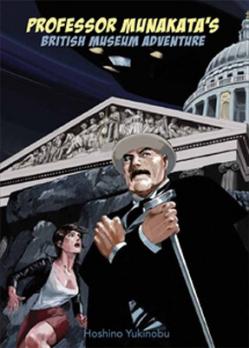Professor Munakata’s Museum Adventure

By Yukinobu Hoshino, translated by Nicole Coolidge Rousmaniere, Hiromi Uchida and Timothy Clark, British Museum Press, 2011, 264 pages, ISBN-13: 978-0714124650, £14.99
Review by Sir Hugh Cortazzi
This is the English version of an original Japanese Manga book. It was translated into English by Nicole Coolidge Rousmaniere with Uchida Hiromi and Timothy Clark. It has to be read from the back as if it were a Japanese book.
As Neil MacGregor, the director of the British Museum explains in his foreword the museum became acquainted with Mr Hoshino Yukinobu when he was making drawings of Japanese clay figures for the recent dogu exhibition at the museum (Also see our review of the Unearthed Exhibition in issue 30). The artist visited the museum and was inspired to produce ten episodes in which his manga character Professor Munakata is involved with objects in the museum’s collection.
Dr Rousmaniere in her introduction explains for readers unfamiliar with the genre that manga “which we might translate playfully as ‘pictures run riot’ is a visually compelling medium that engages the reader in a uniquely effective manner through a combination of pictures and text. They are printed in predominantly black and white and are initially serialized in low cost magazines.” If they become popular they may appear in book form or even inspire anime films.
Hoshino Yukinobu “is one of the most acclaimed manga artists currently working in Japan.” Born in Kushiro, Hokkaido his studio is in Sapporo. Nicole Rousmaniere comments that “Hoshino’s work is characterized by its detailed and yet dramatic drawing style, swift and suspenseful storylines, and the incorporation of actual historical or mythological events in his narratives.” In recent years Hoshino’s stories have concentrated on the character of Munakata Tadakusa, a professor of Ethnology and Folklore at the fictitious Toa Bunka University in Tokyo, “who challenges previous misinterpretations of myths, legends and historic incidents from the ancient past to the present.”
As Hoshino explained to Dr Rousmaniere, in thinking about a manga which would involve the British museum, he first decided that he would like to introduce an airship and then Stonehenge. He explained that he does not see manga as high or fine art, but Ukiyo-e too “was created for the mass public.” He added that he had some fun creating “the story of Professor Munakata and the museum” which was one of his two longest stories.
Tim Clark in a separate essay “From Ukiyo-e to Manga: Japan’s Mischief-making Print Culture” notes that “a manga-like genre which began in 1775, can be found in the popular kibyōshi or yellow cover books.” He points out that “There is a chronological lineage of pre-modern artists of popular illustrated fiction and ukiyo-e prints which leads fairly seamlessly into the world of modern manga. The artists are linked above all by a common predisposition for mischief-making that may well end up being the defining characteristic of the lineage.” The Japan Punch produced by the British artist Charles Wirgman in the Treaty port of Yokohama in the early Meiji period influenced the way in which manga eventually developed in Japan. But he rejects the view that “manga are the modern equivalent of ukiyo-e or that ukiyo-e are the traditional precursors of manga.”
Japanese (and English) readers will find in the drawings an introduction to the contents and work of the museum and to famous places in London as well as to important historical personages. Professor Munakata wanted to see the room where one famous Japanese figure connected with the museum had worked. He was Minakata Kumagusu (1867-1941) who spent so much time in the Reading Room, but the Professor does not seem to have been told that Minakata was twice suspended from entry to the Reading room for causing disturbances (see Carmen Blacker’s portrait of Minakata Kumagusu in Britain and Japan Biographical Portraits volume 1 edited by Ian Nish, Japan Library 1994).
I will not spoil the reader’s enjoyment of the fantastical and fictional elements of the story line by attempting a summary.
If you want more hints about the plot then see our other review of this publication in issue 36.
The book contains a few pages in colour. Here is an example showing the first page which may whet the reader’s appetite to buy a copy of the book:

